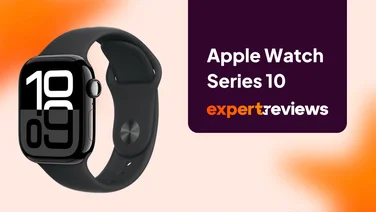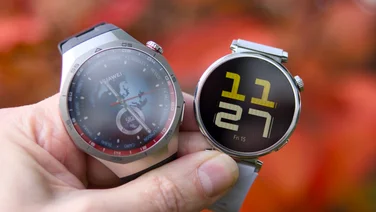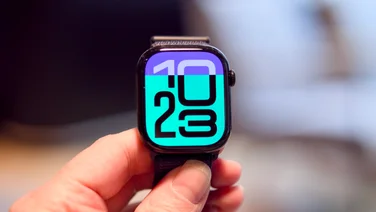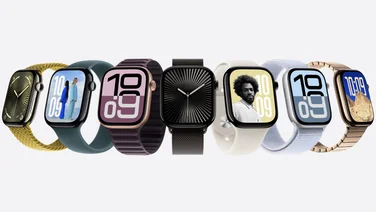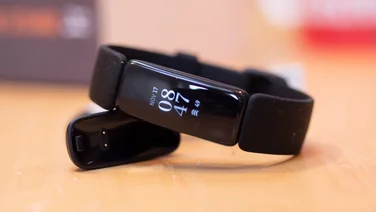To help us provide you with free impartial advice, we may earn a commission if you buy through links on our site. Learn more










- High end build, great attention to detail
- X-Tap feature speeds up certain readings
- Decent accuracy for HR and GPS
- A bit chunky
- Mobile app is messy
The wearables market, particularly smartwatches, is pretty much the last chance saloon for Huawei products in the West, since its smartphones lost Google support and its laptops can no longer run on Windows. The Huawei Watch 5 is the new flagship of the range.
There are more expensive Huawei smartwatches you can buy (the Huawei Watch Ultimate, for example), but the Huawei Watch 5 is the one with the most mass market appeal. It’s the product the Chinese tech giant hopes will steal the spotlight from the Apple Watch. The surprise is that, for the most part, it succeeds.
Huawei Watch 5 review: What do you get for the money?
The materials, general design and features are right up there with the best the smartwatch industry has to offer. Up front is a bright, vivid 3,000 nit LPTO 2.0 screen, which refreshes right down to 1Hz to save on power. This is protected by “spherical” (i.e. curved in all directions) scratch-resistant sapphire crystal glass.










The body of the watch is built from equally tough materials. The cheaper models (both 42mm and 46mm models are £400) come in 316L steel, but if you want something more exotic, the 42mm watch is also available in tough 904L Oystersteel (from £500 ) – the same material Rolex uses in the body of its watches. The 46mm model, rather confusingly, isn’t available in Oystersteel; instead, the step-up model is constructed from titanium alloy and this is also available from £500.
The 46mm model, which I was loaned for this review, is a little on the chunky side for skinny wrists at 15mm thick and weighs quite a bit at 82.4g, even in the more exotic titanium finish. If I was going to purchase one for myself, it would have to be the smaller 42mm model.
Still, that’s pretty much my only complaint here about the design. The elastomer wristbands are comfy and look great – and you can also get the watch with a metal link strap, if that is what you prefer. Personally, I can’t stand them as they always seem just a fraction too tight or too loose, but there is that option with the silver models.










As usual, the Huawei Watch 5 works with both iPhones and Android phones and delivers Apple/Samsung Galaxy Watch-beating battery life with a claimed 4.5 days of regular use (3 days with the always on display enabled or 12 days in battery saver mode) for the 46mm model.
That’s longer than the Huawei Watch 4, which lasted a claimed three days in standard mode, but shorter than the Huawei Watch GT 5, which lasts up to 9 days in standard mode, 5 days with the always-on display enabled and up to 14 days with battery saver enabled.
It tracks all the metrics you need with pretty much no exception, adding HRV for good measure this time around, has plenty of sports modes for workout tracking and, for slightly more serious athletes, there’s a host of workouts and training plans to choose from. It’s also child’s play to create and upload your own structured workouts, and the app will sync your workouts and calendar back and forth to Strava and the adidas Running app.
What did we like about the Huawei Watch 5?
What’s new, then? Aside from that new spherical glass and the new smaller size (the watch was previously only available in 46mm), there are a number of added features this time around.
There’s a selection of new features Huawei has added to this generation and, in general, they enhance the watch’s appeal. The first and most obvious is the new X-Tap sensor, which sits on the right side of the watch case between the clickable, rotating crown and the customisable button to the bottom right.
This multifunction unit contains a pressure sensor, an ECG electrode and a fingertip optical heart rate PPG sensor; the idea behind it is to provide more readings for spot-check health readings. The fingertip contains a higher density of capillaries than the back of your wrist, which is why when you’re in hospital the doctor will attach a clip to the end of your finger to monitor your heart. The X-Tap sensor also speeds up SpO2 blood oxygen saturation readings, reducing the time needed from around 30 seconds of sitting very still to ten seconds flat.










To take advantage of the new sensor, Huawei has introduced a new all-in-one health report feature called Health Glance. This takes 60 seconds and provides an ECG evaluation, measures your resting heart rate, heart rate variability, stress levels, blood oxygen levels and a whole lot more. It even purports to measure respiratory health levels by asking you to cough into the microphone on the watch.
I’ll be honest, I’m not convinced coughing into the tiny microphone of a smartwatch is going to be able to give you much of an insight into your breathing, but the rest seems sound enough from a scientific perspective – and it’s good to get it all delivered in one place. Previously, if you wanted to do a complete health check in all these areas, you’d have to run each test individually and it would have taken a lot longer than a minute. Another nice touch is that you can export all this via PDF to print out and take to the doctor’s with you.
One further new feature worth mentioning here is the “hand gesture” feature – a box-ticking, me-too feature if ever I saw one. This apes the Apple Watch Series 10’s feature, allowing you double-tap the tip of your thumb and forefinger together to carry out certain actions, without having to interact with the watch using your other hand.










You can use it to snooze an alarm, for instance, answer a phone call or pause/play music; and if you swipe your thumb down the side of your forefinger, you can change focus and choose another option – turning the alarm off altogether.
Other things I like are the Watch 5’s offline maps facility – useful for trail runners and hikers – which allows you to import routes via GPX or sync them from Komoot and follow along from the screen of the watch so you don’t have to fish your phone out of your bag or your pocket.
It’s good to finally have an overnight do-not-disturb system that kind of just works. You can now schedule the watch to go into Sleep mode, muting notifications and dimming the screen so it doesn’t blind you when you check the time in the middle of the night.










The super bright display is great. Even in really bright ambient conditions, the peak 3,000 nits brightness means the screen is always clear and extremely easy to read. One word of warning, however: I did find that the polarised lenses on my sunglasses interfered with the display somewhat. The screen was still readable and not black, but instead of cutting down on glare, reflections off the watch’s glass were actually accentuated.
Surprisingly, given the watch’s weight and thickness, the Huawei Watch 5 also performed reasonably well in my heart rate accuracy tests. I usually test wearables for heart rate accuracy side-by-side tests with my Polar H10 chest strap, which delivers reliable accuracy time after time. Here, I saw an average difference between the two of 3.82%.










That’s not the best I’ve seen, and on a couple of runs it went entirely off-beam, locking onto my cadence instead of my heart rate, but if you wait for it to get a lock at the beginning of your workout and warm up properly, the accuracy is pretty decent. If you want more accuracy, you can get that by pairing a Bluetooth chest belt.
The GPS positioning is pretty good, too. The Watch 5 has dual-frequency reception, which should make for better accuracy in built-up areas like city centres. And it delivered an average difference of 2.04% across a variety of tests versus my gen 3 Stryd running pod and a Garmin Forerunner 955. Given that no wearable or fitness tracker is going to give you 100% accuracy, this is about as accurate as you can get.
What could it do better?
Generally, my feelings about the Huawei Watch 5 are positive, but there are plenty of things it could improve. The first thing Huawei could do for a kick-off is remove the need to run through a permissions agreement screen for every single app on the watch. I understand the need for privacy in general and, yes, once done you don’t have to worry about it again, but please Huawei: give me the option to apply a blanket agreement for all apps!
I’d also love to be able to use the routing feature at the same time as structured workouts, but that isn’t possible, which is annoying. You can choose to run or cycle to a preplanned route, but you can’t combine those workouts with structured workouts like intervals
Other niggles surround a couple of the watch’s new features. I found the X-Tap sensor rather finicky, for instance, and it frequently complained of “poor contact”, resulting in a failed ECG test or a completely wonky looking heart-rate trace. It needs the contact pressure to be just right – not too heavy, not too light – or it simply fails. And this can be especially frustrating if it happens right at the end of the 30 seconds it needs to complete an ECG reading.










Another small, and very odd, disappointment is that the list of supported functions for the hand gesture function is very limited. While you can snooze your alarm, which is handy, you can’t do the same with a timer or stopwatch. This is the sort of thing that’s easily fixed via a software update, but for now I wouldn’t say this was any kind of a killer feature.
The final weak spot is the Huawei Health app, which I have moaned about in reviews of the company’s wearables before. While the UI on the watch itself is great, and the app has improved over the years, I still find the layout messy and unintuitive, and certain settings are difficult to find.
One example of this is the route uploading facility. You might think you’d find this in the workout planning section, where you can plan your structured workouts, but no: you need to go to the Me | My routes. Another is the location of the third-party synchronisation options. Again, this is buried in Me | Privacy management | Data sharing and authorisation.
Should you buy the Huawei Watch 5?
Despite the niggles, the Huawei Watch 5 is definitely worth considering. For Apple Watch owners sick of recharging all the time it delivers superior battery life and build, and for anyone else, it delivers most of the functions you need in a smartwatch with few of the compromises we see on other smartwatches.
I think the X-Tap feature needs a bit of work and Huawei probably shouldn’t have bothered with the hand gesture feature if it wasn’t going to go all in. But generally, the Huawei Watch 5 is a great all-rounder: it looks and feels fabulous, it’s competent in pretty much all areas and it’s great value, too.

